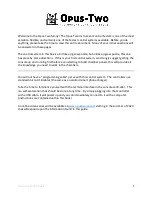
N O T
l
Accuracy of this measurement- depends on the DIS
PERSION
RANGE se ttin g s.
See Characteristics sec-
section.
Frequency S tab ility
The Type 1L30 may be used to measure both long and
short term frequency instabilities, when the local oscillator is
phase locked to a stable crystal-controlled reference fre
quency. See Stability in Characteristics section.
Short term stability measurements apply to fast frequency
changes such as those caused by power supply noise and
ripple, vibration or other random factors. Fig. 2-20 shows
the random frequency modulation characteristics of a kly
stron.
Fig. 2-20 Short term stability msasurment. Random FM character
istic of a klystrom.
DISPERSION is 2 kHz/CM and RESOLUTION
is 1 kHz. Oscillator FM is about 6 kHz.
fun-iii '-’i in -Ifftflrfr'lliV'
Operating Instructions— Type 1L30
fc
Frequency Modulated Spectrum
%
FM measurements generally determines the modulating fre-
f
quency, amplitude of the modulating signal or frequency
[
deviation, and index of modulation. A typical FM spectrum
^
is shown in Fig. 2-15. The exterior modulation envelope
resembles a cos2 curve, which' is an identifying feature of
-
the frequency modulated carrier.
'
?
■
\
y.
I
Frequency Deviation Measurement
There is no clear relationship between spectral width and
deviation, because in theory the FM spectrum approaches
infinity. In practice, however, the spectral level falls .quite
rapidly. See Fig. 2-15B. Accurate deviation measurements
can be made if the modulating frequency and the modulation
index (where the carrier goes to zero) are known.
Modulation Index =
Carrier deviation
Modulating frequency
Values of modulation index corresponding to zero carrier
amplitudes are listed in Table 2-1.
TABLE 2-1
Values of modulation index for carrier
null points
O rder of Carrier Null
Modulation Index
1
2.4
2
5.52
3
8.65
4
11.79
n (n > 4 )
11.79 + (n - 4 )
Accurate carrier null is essential for accurate measurement.
jjy
Long term stability measurements require a recorder, a
series of photographs, or the use of a storage oscilloscope to
show frequency drift as a function of time. Temperature
compensation can be computed by this process.
Amplitude
M o d ula tio n
Modulating frequency or frequencies and modulation per
centage are the quantities most often desired from an AM
signal measurement.
Fig. 2-13 illustrates some amplitude
modulated signals, the methods to measure the modulating
frequency, and modulation percentage.
Over-modulation produces extraneous sidebands resulting
in a spectrum that is very similar re the spectrum of a multi
frequency modulated carrier.
Over-modulation is usually
distinguished from the multi-frequency modulated display
because the spacing between sidebands is equal, while the
sidebands in a multi-frequency spectrum will be arbitrary
unless the modulating frequencies are harmonically related.
The 'over-modulared carrier spectrum is usually symmetrical,
whereas the spectrum of a multi-frequency modulated sig
nal is asymmetrical in amplitude.
Analysis and Measurement from the
Spectrum of a Pulse Modulated Signal
An examination of the spectrum from a pulse modulated
device such as a radar transmitter, provides a variety of in
formation about the system. The amount of frequency shift
(long term or short term) in the display indicates the stability
of the transmitter oscillator. The absence of deep or prom
inent lobe minima's adjacent to the main lobe is an indica
tion of frequency modulation, provided the resolving power
of the analyzer is sufficient. See Fig. 2-18C. Double peaks
in the main lobe indicate that the oscillator is operating
in
two or more modes, which could be caused by some ex
ternal load such as mismatched transmission lines or fluctu
ating supply voltages. A visual indication is provided to
tune the transmitting system so that most of the output power
is within the frequency bandwidth of the receiving system.
The following measurements may be performed from the
spectrum of a pulse modulated display.
Pulse Width: The theoretical pulse width for a square
wave is the reciprocal of the spectral side lobe frequency
width. The main frequency lobe or its side lobes can there
by ■
%
■ -
i
if
Содержание 1L30
Страница 48: ...si L i y n Maintenance Type 1L30 Fig 4 15 Honeycomb assembly drcui a n d component layout 4 n ...
Страница 59: ...Fig 6 1 A Test equipment required for calibration ...
Страница 60: ... Calibration Type 1130 ...
Страница 120: ...T Y P E I L 3 0 S P E C T R U M A N A L Y Z E R ib i IF SYSTEM BLOCK DIAGRAM 9 1 9 2 ...
Страница 127: ......
















































